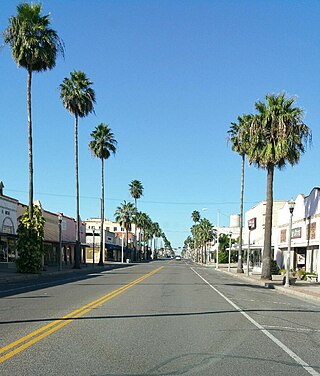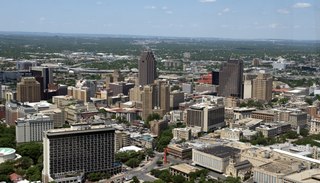
Willacy County is a county in the U.S. state of Texas. As of the 2020 census, its population was 20,164. Its county seat is Raymondville. The county was created in 1911 and organized the next year.

Starr County is located in the U.S. state of Texas. As of the 2020 census, its population was 65,920. Its county seat is Rio Grande City. The county was created in 1848. It is named for James Harper Starr, who served as secretary of the treasury of the Republic of Texas.

Hidalgo County is located in the U.S. state of Texas. The county seat is Edinburg and the largest city is McAllen. The county is named for Miguel Hidalgo y Costilla, the priest who raised the call for Mexico's independence from Spain. It is located in the Rio Grande Valley of South Texas and is one of the fastest-growing counties in the United States. As of the 2020 census, the population of Hidalgo County was 870,781, making it the eighth-most populous county in Texas. Hidalgo County is designated by the U.S. Census Bureau as the McAllen-Edinburg-Mission metropolitan statistical area, which itself is part of the McAllen-Edinburg-Mission-Rio Grande City, Texas combined statistical area with neighboring Starr County.

Donna is a city in Hidalgo County, Texas, United States. The population was 16,797 at the 2020 census.

Edinburg is a city in and the county seat of Hidalgo County, Texas, United States. Its population was 74,569 as of the 2010 census, and in 2019, its estimated population was 101,170, making it the second-largest city in Hidalgo County, and the third-largest city in the larger Rio Grande Valley region.

Granjeno is a city in Hidalgo County, Texas, United States. The population was 293 at the 2010 census. The city sits on the banks of the Rio Grande, near the border with Mexico. Its name comes from the granjeno tree or spiny hackberry.

Hidalgo is a city in Hidalgo County, Texas, United States. The population was 11,198 at the 2010 census, and in 2019 the estimated population was 14,183.

McAllen is the largest city in Hidalgo County, Texas, United States, and the 22nd-most populous city in Texas. It is located at the southern tip of the state in the Rio Grande Valley, on the Mexico–United States border. The city limits extend south to the Rio Grande, across from the Mexican city of Reynosa. McAllen is about 70 mi (110 km) west of the Gulf of Mexico. As of the 2020 census, McAllen's population was 142,210. It is the fifth-most populous metropolitan area (McAllen–Edinburg–Mission) in the state of Texas, and the binational Reynosa–McAllen metropolitan area counts a population of more than 1.5 million.

Weslaco is a city in Hidalgo County, Texas, United States. As of the 2020 census the population was 41,103, and in 2020 the estimated population was 41,103. It is located at the southern tip of Texas in the Rio Grande Valley near the Mexican border, across the Rio Grande from the city of Nuevo Progreso, Rio Bravo, Tamaulipas.

Rio Grande City is a city in and the county seat of Starr County, Texas. The population was 14,411 at the time of the 2020 census. The city is 41 miles (66 km) west of McAllen. The city also holds the March record high for the United States at 108 °F (42 °C). The city is connected to Camargo, Tamaulipas, via the Rio Grande City–Camargo International Bridge. The city is situated within the Rio Grande Valley.

The Thornton Affair, also known as the Thornton Skirmish, Thornton's Defeat, or Rancho Carricitos was a battle in 1846 between the military forces of the United States and Mexico 20 miles (32 km) west upriver from Zachary Taylor's camp along the Rio Grande. The much larger Mexican force defeated the Americans in the opening of hostilities, and was the primary justification for U.S. President James K. Polk's call to Congress to declare war.

The Lower Rio Grande Valley, commonly known as the Rio Grande Valley or locally as the Valley or RGV, is a region spanning the border of Texas and Mexico located in a floodplain of the Rio Grande near its mouth. The region includes the southernmost tip of South Texas and a portion of northern Tamaulipas, Mexico. It consists of the Brownsville, Harlingen, Weslaco, Pharr, McAllen, Edinburg, Mission, San Juan, and Rio Grande City metropolitan areas in the United States and the Matamoros, Río Bravo, and Reynosa metropolitan areas in Mexico. The area is generally bilingual in English and Spanish, with a fair amount of Spanglish due to the region's diverse history and transborder agglomerations It is home to some of the poorest cities in the nation, as well as many unincorporated, persistent poverty communities called colonias. A large seasonal influx occurs of "winter Texans" — people who come down from the north for the winter and then return north before summer arrives.

South Texas is a region of the U.S. state of Texas that lies roughly south of—and includes—San Antonio. The southern and western boundary is the Rio Grande, and to the east it is the Gulf of Mexico. The population of this region is about 4.96 million according to the 2017 census estimates. The southern portion of this region is often referred to as the Rio Grande Valley. The eastern portion along the Gulf of Mexico is also referred to as the Coastal Bend.

The Payne Arena is a multi-purpose complex, in Hidalgo, Texas. It was formerly known as Dodge Arena from 2003 until February 2010, State Farm Arena from 2010 to September 2018, and then State Farm Hidalgo Arena for one year.
The World Birding Center is the official title given to a combined nine parks and nature preserves in the Rio Grande Valley region of Texas managed by a partnership of the Texas Parks and Wildlife Department, the United States Fish and Wildlife Service, and the local communities in which the parks reside. The stated mission of the World Birding Center is to "protect native habitat while increasing the understanding and appreciation of the birds and wildlife", with an additional emphasis on promoting local economic development through ecotourism.

Bentsen-Rio Grande Valley State Park is located at 2800 S. Bentsen Palm Drive south of the city of Mission in Hidalgo County in the U.S. state of Texas. It serves as the headquarters for the World Birding Center.
The following is a timeline of the history of the city of Laredo, Texas, USA.
Silvia Hector Webber and John Fernando Webber were a mixed-race couple who were among the initial settlers in Austin's Colony in Travis County, Texas. John, previously a private and a medic during the War of 1812, was the first non-native resident and the founder of Webber's Prairie, where he had established a fort. The town was later named Webberville, Texas. The Webbers secured the freedom of Sylvia and their children ultimately by giving up much of their Webberville property. The family was subject to cruel racial prejudice and their children were unable to attend school with white children. The Webbers hired a live-in private tutor.
Matilda Hicks and Nathaniel Jackson (1798–1865) were an interracial couple who helped fleeing enslaved people between 1859 and 1865. They offered a safe-haven and a ferry ride across the Rio Grande into Mexico. They were driven by their religious and anti-slavery beliefs. It is said they helped anyone in need.
The Jackson Ranch Church also called the Jackson Methodist Church was established in 1884 from land donated by Martin Jackson, the son of the settlers Matilda and Nathaniel Jackson. Previously, a church was built by the Jackson family of adobe and logs in 1874 or 1875, but it was washed away in a flood. It began as a Methodist Episcopal Church and remained so for fifty years, until the minister retired. After that, it alternatively served as a Methodist and Lutheran Church. There is a cemetery at the church and another cemetery about two blocks away, the Eli Jackson Cemetery which was established in 1865 by Martin's brother Eli.












